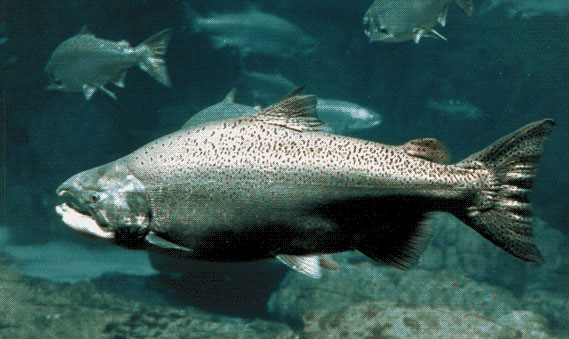The king salmon did not appear, and not only in Yukon.
The rivers in Alaska stopped stopping this fish because a large number did not return to reproduce. The number of fish returning to record low levels, along with poor fish stocks in the summer of last year and 2007, led to an emergency stop for fishing.
Leslie Hunter, a 67-year-old shop owner and a commercial fisherman from Yup'ik Eskimo village, Marshall in western Alaska, said : 'Winter will be very difficult, that's a sure thing.' State and federal biologists are investigating this mystery.
King salmon lived for many years in the Bering Sea and as adults they returned to the river where they were born to breed and die. Biologists predict that the main reason is the ocean circulation in the Pacific. However, the abundance of food, changing river conditions and predator relationships - prey may also affect this fish.
People living along the banks of the Yukon River believe that they know what is the source of this tragedy - the fishpond fishery. This fishing ground - the largest in the country - catches about 1 million tons of carp per year in the east of the Bering Sea, with a trade value of up to $ 1 billion.
 King salmon. (Victorialodging) King salmon are trapped in fishing nets used to catch pollock, and dead salmon are often thrown back into the sea. Some are donated to the poor.
King salmon. (Victorialodging) King salmon are trapped in fishing nets used to catch pollock, and dead salmon are often thrown back into the sea. Some are donated to the poor. Nick Andrew Jr., director of the Ohagamuit Traditional Council, said: 'We know the fact that the fishpond fishing grounds are wiping out the king's salmon reserves for all tributaries. They are taking away our source of life. '
Since 2000, the number of captured king salmon has increased rapidly, reaching 120,000 in 2007. A significant amount of them belong to the rivers of western Alaska. If these fish are alive, about 78,000 adult fish can return from the Pacific Northwest to Western Alaska.
Efforts to minimize 'catch' are not new. In 2006, a law was passed that forced polyolefishers to leave areas where a large number of king salmon were caught 'wrong'.
Last April, the North Pacific Fisheries Management Council, a marine fish management organization, adopted a tighter limit for the polyculture industry. Starting in 2011, those participating in the program were allowed 60,000 king king salmon a year. If this limit has been reached, the fishing ground will be closed. Non-participating boats have a lower limit - 47,951 children.
The absence of king salmon is causing serious economic consequences for the villages . In many villages, spring floods washed away houses, boats, fishing nets and even drying places. People do not have enough money to buy anything.
Andrew said: 'This phenomenon is badly affecting the economy in all river areas where dependence on commercial fishing is the main source of income'.
However, this is not the only reason for the loss of king salmon, Dian Stram, Council coordinator, said.
Herman Savikko, a biologist from the Alaska Department of Hunting and Fishing, agrees. He pointed out that the change of ocean currents, plankton plankton, and even the carnivorous nature of salmon are potential causes. Conditions in rivers may also be changing.
Savikko commented: 'There is still a lot of unknown about what happened to king salmon'.
In a lucky year, Kwik'pak LLC Fishery in Emmonak lowers Yukon to hire from 200 to 300 people. This summer, only about 30 people were hired. Kwik'pak is the largest employer in the region.
Manager Jack Schultheis said when the king salmon catch was closed, the flock of Chum salmon also decreased, although a large number of chum salmon returned to the river.
The economy at the downstream villages of Yukon was badly affected, he concluded.
Fishermen often earn between $ 5 million and $ 10 million from fishing. Last year, this number dropped to $ 1 million.
This means that instead of earning 20,000 to 30,000 dollars in the 1970s, fishermen now earn only a few thousand dollars. While petrol costs $ 8 a gallon, milk costs $ 15 a gallon.
It is hard to imagine the villages falling into such economic difficulties. However, the situation in Yukon should be carefully controlled until the problem of the king salmon disappearance is better understood. Schultheis said: 'In 50 years, the fishing work here has always been stable'.
 Animal 'suffering' after hibernation
Animal 'suffering' after hibernation Why do goats climb well?
Why do goats climb well? Scientists were surprised to see chimpanzees eating turtles
Scientists were surprised to see chimpanzees eating turtles Giant catfish died deadly due to drought in Thailand
Giant catfish died deadly due to drought in Thailand